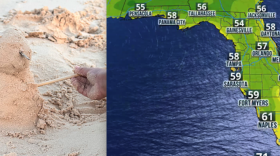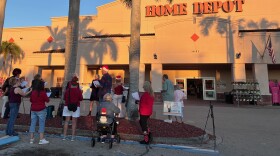AILSA CHANG, HOST:
Many tattoo studios have a pretty consistent look and structure - neon in the window, pages of flash hung on the walls and apprentices keeping the studio clean and practicing on oranges while senior artists tend to the clients. Now a new generation of tattoo artists is doing things a little differently. NPR's Linnea Anderson reports.
ELLA SKLAW: Hi. I'm Ella.
LINNEA ANDERSON, BYLINE: In Brooklyn, N.Y., tattoo artist Ella Sklaw greets their next client.
SKLAW: So nice to meet you, Maddie (ph). Have you been to Nice Try before?
MADDIE DENNIS-YATES: No, I haven't.
SKLAW: OK. Amazing. Welcome. Bathrooms are...
ANDERSON: Sklaw started Nice Try Tattoo with their friend and fellow artist, Cierson Zambo. Five artists work out of the collaboratively owned and operated space. From the outside, it's an unassuming warehouse. But once you enter, you're met with comfy couches, walls plastered with thank you notes and a wooden dining table in the back. Despite being only open for three years, it looks lived-in, adorned and curated. Clients like Maddie Dennis-Yates (ph) prefer this atmosphere.
DENNIS-YATES: There's been a real shift in the vibe of tattoo studios lately. Just having it in a building like this, like, it's got this sort of coziness to it. You have to, like, go find it somewhere. You can't just, like, stumble in off the street.
ANDERSON: In a typical studio, artists schedule some of their work ahead of time but also take walk-in clients. At Nice Try, artists schedule all of their work. That gives them the freedom to choose what and how they tattoo. For Abbie Inwesen, a guest artist at Nice Try, that means using a singular needle to etch designs into the skin instead of a typical machine, which uses multiple. In fact, this technique, often referred to as stick and poke or hand poke, is how many independent artists get their start, including those who now use machines.
ABBIE INWESEN: And I think stick and poke, for a long time, was kind of regarded as not very serious, like, in the tattoo industry, but now you can find artists in studios, like, all around the world that do it, which is really, really cool.
ANDERSON: Cruise back to that communal table in the rear of the studio, and Nice Try's artists recall their early days teaching themselves to tattoo.
SYDNEY KLEINROCK: We have India ink and a sewing needle. Want to tattoo a planet on my back? I'm like, sure...
LU WALSTAD: Yeah.
KLEINROCK: I guess so.
CIERSON ZAMBO: It's a formative experience.
ANDERSON: Researchers say that collaborative workspaces like Nice Try are part of a bigger economic shift, even beyond the tattoo industry. Trebor Scholz is a New School professor who researches cooperative entrepreneurship.
TREBOR SCHOLZ: They are made to look as if they are aberrations when, in fact, this is something that is happening around the world, right? So you have a movement that is actively bringing cooperative principles into the ditch of an economy (ph).
ANDERSON: Still, some tattoo artists make the case that there are benefits to the traditional shop model that are lost when artists work out of independent studios.
MEHAI BAKATY: I think it's harder to advance as an artist. I think you need that interaction with the average daily wacko wandering in off the street.
ANDERSON: Mehai Bakaty owned Fineline Tattoo, allegedly the oldest tattoo studio in Manhattan. But the COVID lockdown forced him to close shop, and now he works from an independent studio. He says New York tattoo shops all used to operate under the radar because up until the '90s, their practice was illegal due to concerns about HIV transmission.
BAKATY: Sort of underground, clandestine, appointment only, word of mouth, no advertising, no storefront.
ANDERSON: Word of mouth, no storefronts sounds a little like the way independent artists do their business nowadays. It's a lineage the artists at Nice Try told me they cherish. And whether clients choose a machine or hand-poke tattoo at an indie studio or a shop, the idea is the same - art with permanence. Here's Lars Krutak, a tattoo anthropologist.
LARS KRUTAK: Tattoos were - I mean, perhaps culturally, they were always something to be extremely proud of. I mean, they're basically primarily these - tattoos were cultural identifiers and identify you a member of a community.
ANDERSON: So when clients leave Nice Try, they aren't just coming home with fresh ink.
E BARNICK: Oh, I love it.
ANDERSON: It's a mutual exchange. The artists get to bask in the delight of another happy customer.
UNIDENTIFIED PERSON #3: Cute.
UNIDENTIFIED PERSON #4: So cute.
ANDERSON: And the marking is a symbol of a community much bigger than a singular artist or a singular needle. Linnea Anderson, NPR News.
(SOUNDBITE OF MUSIC) Transcript provided by NPR, Copyright NPR.
NPR transcripts are created on a rush deadline by an NPR contractor. This text may not be in its final form and may be updated or revised in the future. Accuracy and availability may vary. The authoritative record of NPR’s programming is the audio record.







